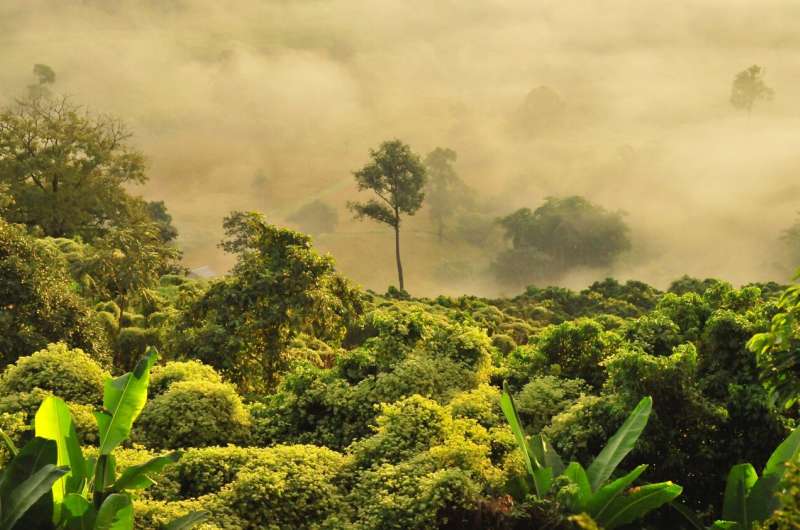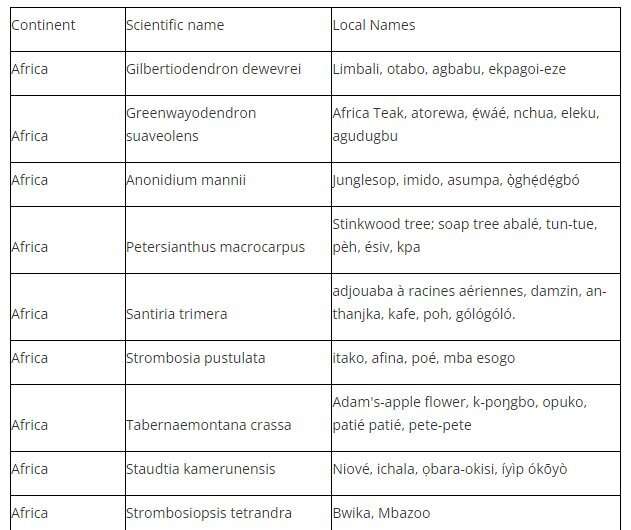This article has been reviewed according to Science X's editorial process and policies. Editors have highlighted the following attributes while ensuring the content's credibility:
fact-checked
peer-reviewed publication
trusted source
proofread
Scientists name the most common tropical tree species for the first time

A major international collaboration of 356 scientists led by UCL researchers has found almost identical patterns of tree diversity across the world's tropical forests.
The study of over one million trees across 1,568 locations, published in Nature, found that just 2.2% of tree species make up 50% of the total number of trees in tropical forests across Africa, the Amazon, and Southeast Asia. Each continent consists of the same proportion of a few common species and many rare species.
While tropical forests are famous for their diversity, this is the first time that scientists have studied the commonest trees in the world's tropical forests.
The scientists estimate that just 1,053 species account for half of the planet's 800 billion tropical forest trees. The other half is comprised of 46,000 tree species. The number of rare species is extreme, with the rarest 39,500 species accounting for just 10% of trees.
Lead author Dr. Declan Cooper (UCL Geography and UCL Center for Biodiversity and Environment Research) said, "Our findings have profound implications for understanding tropical forests. If we focus on understanding the commonest tree species, we can probably predict how the whole forest will respond to today's rapid environmental changes. This is especially important because tropical forests contain a tremendous amount of stored carbon, and are a globally important carbon sink."
He continued, "Identifying the prevalence of the most common species gives scientists a new way of looking at tropical forests. Tracking these common species may provide a new way to characterize these forests and in the future possibly gauge a forest's health more easily."
The researchers found strikingly similar patterns in the proportion of tree species that are common, at close to 2.2%, despite the tropical forests of the Amazon, Africa and Southeast Asia each having a unique history and differing contemporary environments.
The Amazon consists of a large region of connected forest, while Southeast Asia is a region of mostly disconnected islands. People only arrived in the Amazon around 20,000 years ago, but people have been living in African and Southeast Asian forests for more than twice that length of time. In terms of the contemporary environment, African forests experience a drier and cooler climate than the other two tropical forest regions.
Given these striking differences, the near-identical patterns of tree diversity suggest that a fundamental mechanism may govern the assembly of tree communities across all the world's tropical forests. The researchers are not yet able to say what that mechanism might be and it will focus future work on identifying it.
The estimates of common species derive from statistical analyses, which do not provide the names of the common trees. To overcome this, the scientists used a technique known as resampling to estimate which are the most likely names of the common species.
Their list of 1,119 tree species names, the first list of common species of the world's tropical forests, will allow researchers to focus their efforts on understanding the ecology of these species, which in turn can give scientists a shortcut to understanding the whole forest.

Senior author, Professor Simon Lewis (UCL Geography and University of Leeds) said, "We wanted to look at tropical forests in a new way. Focusing on a few hundred common tree species on each continent, rather than the many thousands of species that we know almost nothing about, can open new ways to understand these precious forests."
"This focus on the commonest species should not take away from the importance of rare species. Rare species need special attention to protect them, but quick and important gains in knowledge will come from a scientific focus on the commonest tree species."
The researchers assembled forest inventory data from intact tropical forests that hadn't been affected by logging or fire. In each of the 1,568 locations, teams identified and recorded every tree with a trunk greater than 10 centimeters in diameter, in a patch of forest, usually one hectare, which is a square of forest measuring 100 meters on each side.
Professor Lewis has been collecting and collating this data for 20 years. The effort is a collaboration of the largest plot networks across the Amazon (Amazon Tree Diversity Network; RAINFOR), Africa (African Tropical Rainforest Observatory Network, AfriTRON; Central African Plot Network), and Southeast Asia (Slik Diversity Network; T-FORCES), brought together for the first time for the published analysis.
This collaboration across hundreds of researchers, field assistants, and local communities resulted in a total of 1,003,805 trees sampled, which included 8,493 tree species, across 2,048 hectares, equivalent to almost eight square miles of forest. The teams inventoried 1,097 plots in the Amazon totaling 1,434 hectares, 368 plots in Africa totaling 450 hectares, and 103 plots in Southeast Asia totaling 164 hectares.
More information: Declan Cooper, Consistent patterns of common species across tropical tree communities, Nature (2024). DOI: 10.1038/s41586-023-06820-z. www.nature.com/articles/s41586-023-06820-z
Journal information: Nature
Provided by University College London





















